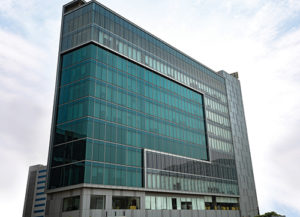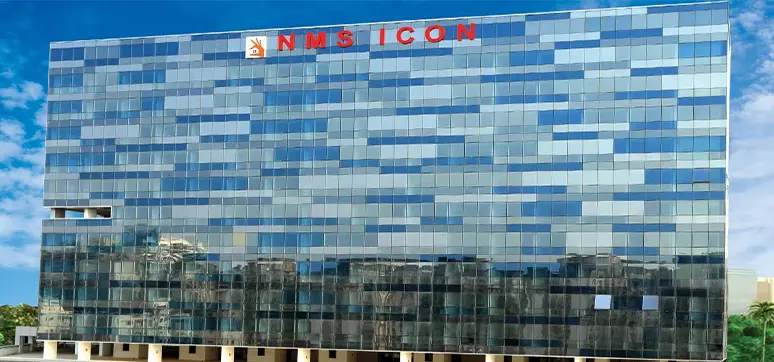What is your view on the growing demand for Smart Glass in niche and low-rise applications?
Smart Glass for façades and cladding is becoming more commonplace, because of the sheer functionality of the material. Energy-efficient glazing in the vision area optimises the natural daylight and the heat ingress into the building. To have smart glass cladding in both interior and exterior applications, makes it easy to clean and maintain, while making the architectural element aesthetically appealing. Smart Glass also yields itself to multiple applications; the increasing use of glass is only natural considering our changing architecture, limited space, larger floor space, and an increasing emphasis on user comfort (thermal, acoustic and visual). Applications of glass and related solutions in niche applications are more prevalent, because of increasing consumer awareness, global sensibilities of designers and improved technology from a manufacturing standpoint for customisation.
Throw some light on the choice of glass for windows / effective fenestration?

Kanak NMS Icon is a commercial development of Kanak Infrastructure, located in Navi Mumbai (Products: SGG Nano – Icy Menthol (KT 140), SGG Nano – Moonshine (KT 155), SGG Cool-Lite – Sterling Silver (ST 120), SGG Antelio Plus – Blue Ray (ST 767))
The choice of Smart Glass for windows or effective fenestration is to be built primarily on the understanding of the local climatology and the intended use of the building with the end objective being overall wellbeing of the end user. To make the choice, it is important to define wellbeing for the end user, which can be defined as a sense of comfort (thermal, visual or acoustic) along with being sustainable and not adversely affecting the environment.
Ceebros One 74, a residential project at Chennai (Products: SGG Planitherm – Pristine White (PLT T), SGG Antelio Plus – Sparkling Ice (ST 167))
An analysis of the energy consumption pattern of both the residential and commercial segment shows that about 70 – 80 percent of energy consumption goes for lighting and air-conditioning. In the residential segment, the ECBC mandates the use of high performance glass in buildings. This is to optimise the natural light and reduce the heat ingress into homes. For a commercial application on the other hand, where the window wall ratio (WWR) is over 45 percent, the choice of the Smart Glass should also consider passive elimination of glare condition.
Please brief on limitations of having complete glass walls on buildings considering Indian climatic conditions?

Architectural glass is a material that exists in plurality. This plurality has overcome what used to be the limitations of using glass in buildings, in the early days of architectural applications of glass. Today’s glass not only boasts of extremely high energy-efficiency, but it also has superior technology that makes façades dynamic and responsive to the environment, thus making the users comfort a supreme attribute.
Notwithstanding the complete glass walls of buildings, one can have complete glass walls in the interiors too without any limitations. Modern glass has addressed every need of the discerning consumer of today. Feeling safe and secured in an environment is as essential for well-being of occupants as acoustic or thermal comfort. Glass from (Vetrotech Saint-Gobain) as a fire resistant wall, can withstand fire for about 120 minutes.
These products apart from adding aesthetic and functional value to the building, also limit the spread of fire, flue gases within the fire compartment of origin protect from high temperatures and thus enable easier fire-fighting evacuation.
Having said that, the use of glass in buildings needs to be optimised based on the location of the building, the prevailing climatic conditions and the intended use of the building. Combining glazing with other building materials would help to combine the strengths of different building materials in allowing the right amount of light (ambient & optimum day lighting without glare) and maintaining the right amount of heat (through insulation) in the building for the benefit of the end user.
Have we cracked the need for energy-efficient Smart Glass, the one suitable for local conditions?

With natural daylighting, and the use of light shelves / light tunnels, artificial lighting can be reduced to a substantial amount. Using a glass of superior selectivity also gives the user the opportunity to gain from the natural daylight and also keep out the direct and indirect heat. To achieve a carbon neutral building, active measures such as power generation, waste management, etc. needs to be employed apart from the more important passive features such as building design.
This can be done by consciously designing the right orientation, for the right cooling/ heating loads and decreasing the dependency on artificial lighting. The use of energy-efficient glass plays a significant role in the part of passive features and needs to be considered during the design phase of the building.
Brief on light and heat management in buildings with glass façades.

The light ingress into the building is largely dependent on factors such as orientation, WWR, and shading factors. Heat gain can both be direct or indirect heat. The direct heat is the amount of solar heat transmitted into the building from the amount of solar heat incident on the glazing.
This is measured by a parameter known as the Solar Heat Gain Coefficient (SHGC) or solar factor. Indirect heat gain is based on the property of thermal insulation of the façade material. This is measured by the parameter called U-value. The U-value of the façade (combination of glass and other materials determines the indirect heat gain of the building). Selectivity, which is the ration between the visual light transmission and the solar factor of the glass has become the most common thumb rule to make the choice of glass for a project requirement.
Please tell us about the performance of glass in acoustic insulation?
Glass can play an important role in acoustic insulation. Thicker glass, laminated glass and glass in asymmetric Double Glazed Units (DGUs) help to attain substantial dB reduction of even up to 50 dB when used in combination of the appropriate interlayers. In terms of exterior glazing, Saint-Gobain has developed a technology to retrofit existing façades that was built a decade back, with basic single glazing. This retrofitting can help structures, improve the acoustic insulation in the interiors and also give additional benefits in terms of heat cut off and glare control. Maersk, Bengaluru (Products: SGG Planilaque – Titanium Grey)
Considering glass as the material in demand for façades, what should be the next in building intelligent futuristic façades?
With manufacturers today, offering state-of-the-art intelligent glass that can respond to the environment, architects have begun their adoption in the buildings they create. Recent developments like LED integrated glass façade, Electrochromic façades, etc., are in this direction.
Yahir Auditorium, Thiruvalla, Kerala (Product: SGG Midas Gold)
There are dynamic glazing solutions such as SageGlass that tints on demand and can be integrated with the overall building management system to build intelligent buildings that are efficient in use and easy to maintain. With an enhanced rate of adoption, it is just a matter of time before futuristic buildings become commonplace in the Indian skyline. As manufacturers, our R&D centers are constantly innovating to build new products and solutions that can serve the façades of today and tomorrow in an intelligent, energy-efficient and sustainable manner. It is this sense of agility from manufacturers and eager experimentation from designers that will help us leapfrog into the arena of ‘futuristic façades’.














